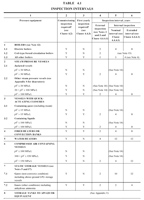Pressure equipment
- Tank designed to AS1200 - view compliance plateAS1200- 2.1 and 2.2
2.1 BASIC REQUIREMENTS AND RECOMMENDATION
Pressure equipment covered by this Standard and used or intended for use in Australia or New Zealand—
- shall comply with the construction and use requirements specified in the Standards listed in Table 2.1 or equivalent agreed by the parties concerned; NOTE: See Figure G1 in Appendix G for organization of Australian, New Zealand and other pressure equipment Standards.
- shall comply with applicable legislative or regulatory requirements;
- shall comply with applicable contractual requirements; and
- should comply with the safety recommendations given in Appendix J.
2.2 COMPLIANCE STANDARDS
Compliance with the applicable Standards listed in Table 2.1 is deemed to satisfy Clause 2.1(a) and (d). Where a Standard is used, that Standard and all its referenced Standards shall be as referenced in their entirety, except as provided by Clause 2.3. Published application Standards should be viewed only as a starting point in the control of risks. It should not be assumed that a design that meets the Standard is without risk. This is because the Standard itself may not deal with all the matters relevant to hazard identification, risk assessment and risk control for the plant in question. Appropriate judgement needs to be exercised in such circumstances. Designers, when designing plant to specifications in published application Standard(s), such as those listed in Table 2.1, shall determine whether the Standard(s) fully deals with the risk to health or safety identified in the risk assessment process. This should involve a systematic assessment of whether the application Standard(s) apply to the whole plant or only certain parts of the plant and an assessment of the adequacy of the Standard(s) in controlling a particular type of risk, having regard to the state of knowledge. If designing the plant in accordance with application Standard(s) listed in Table 2.1, or any other published application Standard, does not eliminate the risk to health or safety, the designer is required to reduce the risk so far as is practicable by altering the design of the plant. If the redesign still does not adequately control the risk, the designer is required to specify the risk control measures that require implementation when the plant is used.
2.3 MIXING STANDARDS
Pressure equipment shall comply with the full requirements of a Standard, except when the equipment or parts of the equipment comply with the more appropriate requirements of other pressure equipment Standards provided—
- such Standards comply with an agreed alternative or equivalent and are applicable to the particular pressure equipment;
- the relevant requirements of the Standards apply to the parts concerned;
- at the interfaces between the parts with different Standards, the parts comply with both Standards as appropriate;
- the design data, drawings and manufacturer’s data report clearly identify and record departures from the principal Standard;
- the equipment marking includes the two main Standards used;
- the overall equipment complies with Clause 2.1; and
- Design pressure, capacity in cubic metresAS1200 - table 2.1
Click image to enlarge
- Maintenance ( 10 Year internal / 2 year external - Table 4.1 AS 3788 (2006) )AS3788- table 4.1 section 7
Click image to enlarge

